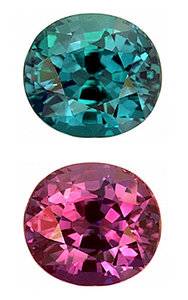Shazbo
Rough_Rock
- Joined
- May 13, 2018
- Messages
- 13
There are the flame fusion synthetic alexandrite-like sapphires and also synthetic alexandrite that are made by several companies using various methods. The flame fusion normally are an easy ID with a distinctive color that I have also seen in natural alexandrite, but only rarely. Under the microscope it is usually possible to find curved striae in the synthetic sapphire, which are 100% proof positive of synthetic origin. As Christine Rose stated, the flame fusion synthetic sapphires have a narrower range of colors than you could see in a genuine color change alexandrite. For example, I have yet to see a flame fusion sapphire w ith any green in it. I do not think they exist, yet, but someday, who knows?
Some of the synthetic alexandrite made by such methods as flux fusion are incredibly realistic looking and much harder to differentiate from the natural.
Wink

Color change sapphire was often sold as alexandrite, especially in Alexandria, Egypt, and it has a much narrower range of color change. But I think it looks like synthetic alexandrite, which I think has a better range of color change than most natural stones.
The symbols look like fake Egyptian hieroglyphics, which would also point to Alexandria. The Alexandria the stones were named for was a Russian Czarina, and alexandrite is not mined in Egypt.
Thank you. The rings were not bought in Egypt but just had these markings so not entirely sure when or where my rings origins are
If the truth is that they are synthetic colour change sapphire, or sapphire would they have that range of colour change possibility?
Thanks again